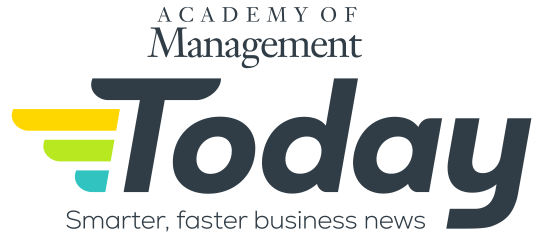Published on: June 2, 2025 at 5:49 pm
By Nick Keppler
Spurred by the racial reckoning after the 2020 police murder of George Floyd, many large, public-facing companies in the U.S. implemented diversity, equity, and inclusion (DEI) programs with the stated goal of addressing their own barriers to hiring of, and advancement for, historically disadvantaged groups.
Too often, these efforts are only aimed at what Academy of Management Scholar Herman Aguinis of George Washington University calls “surface-level diversity,” the presence of people of different races, ethnicities, genders, and other classifications without a change in corporate culture led by executives who value varying perspectives.
“Deep-level diversity is when you have people around the table who bring different experiences and opinions and perspectives to the table, and organizational leaders listen to those diverse voices,” Aguinis said, who has both researched and consulted on institutional barriers that prevent the rise of “star performers” from various backgrounds.
“Surface-level diversity is when you look at someone’s gender, skin color, or race or ethnicity, and that’s what you call diversity,” he said. “It’s much easier to go for surface-level diversity.”
This gravitation towards superficial diversity often starts at the recruitment and interview stages. People in charge of hiring tend to like people with views and appearances similar to their own, said Aguinis, and they can slip into looking for candidates who have the same race, ethnicity, gender, and background as they do.
To prevent bias from creeping into the recruitment and hiring processes, Aguinis recommends conducting structured interviews.
“In a structured interview, you ask the same questions to all the candidates, and you actually score the answers with a scoring key you have created in advance,” he said. “If you have an unstructured interview, where you just chit-chat with a candidate, you’re more likely to like them or not, based on how similar they are to you.
“Also, you should never have just one interviewer because that person’s biases are more likely to be undetected.”
Aguinis added that the perception of a superficial quota system is one cause of a backlash that has led many companies to roll back or rebrand DEI efforts.
“When companies use it—the shortcut of surface-level diversity and just trying to use quotas or things like that—that’s when the diversity seems to be the opposite of what it tries to do: being exclusive instead of inclusive,” he said.
-
Nick Keppler is a freelance journalist, writer, and editor. He has written extensively about psychology, healthcare, and public policy for The New York Times, The Washington Post, Slate, The Daily Beast, Vice, CityLab, Men’s Health, Mental Floss, The Financial Times, and other prominent publications (as well as a lot of obscure ones). He has also written podcast scripts. His journalistic heroes include Jon Ronson, Jon Krakauer, and Norah Vincent.
Before he went freelance, he was an editor at The Houston Press (which is now a scarcely staffed, online-only publication) and at The Fairfield County Weekly (which is defunct).
In addition to journalism, he has done a variety of writing, editing, and promotional development for businesses and universities, including the University of Pittsburgh and Carnegie Mellon University, and individuals who needed help with writing projects.
View all posts
Tagged #ManagerEffectiveness #LeadershipChallenges #WorkplaceCulture #OrganizationalBarriers, bias, DE&I, equity, ethnicity, hiring bias, inclusion, job interview bias, line managers, management, manager learning and development, manager promotions, manager training, managers, middle managers, race, recruitment bias, skin color, surface-level diversity, tokenism
Up next....
The Employee-Employer Relationship Has Changed for the Worse
Source: Shutterstock
By Nick Keppler
In one recent survey, 54 percent of hiring managers at technology companies said they expect layoffs in 2025 as more tasks are performed by AI. Although U.S. President Donald Trump’s tariff plans have been delayed and mitigated by a growing list of exemptions and ongoing negotiations between the U.S. and targeted countries, tariff-related price uncertainty and shipment delays have created a wave of stagflation anxiety and recession fears in the U.S., which could spur companies to slash jobs, which in turn would worsen the growing economic crisis.
Academy of Management Scholar Herman Aguinis of the George Washington University School of Business said that a few decades of mass layoffs and wages not keeping up with inflation have fundamentally changed the employee-employer relationship in the U.S. When looking to improve the bottom line, companies often eye trimming payroll because it is such a huge expense.
“For many organizations, the lion’s share of the operating budget is payroll, two-thirds or more,” Aguinis said. “It could be 80 percent or 85 percent.”
The cost-cutting approach that sees employees as expenses more than assets can be shortsighted, he said. Moreover, many companies lack an effective performance management system and, in mass layoffs, cut high-performing and low-performing employees alike.
Since the 1990s, when companies, particularly in the tech sector, regularly pruned their workforce as a cost-saving measure, despite a booming economy, much of the workforce has begrudgingly come to accept that they can lose their job in a corporate reshuffling, regardless of their job performance. Aguinis said this has damaged the psychological contract between employee and employer that engendered mutual loyalty.
“In the post-World War II era, it was understood that if you do your job, you will not be fired, and you will also not leave, even if they pay you a little more somewhere else,” he said. “We had this implicit loyalty in the old psychological contract.”
Under the new employment-at-will standard, there is no psychological contract, and most employees are always tabulating their value and waiting for the ax to fall.
“If you’re not adding value to your company, they can fire you at any time,” Aguinis said. “On the flip side of the coin, if you’re a star performer and adding a lot of value, you get offers, and you can just go to a new employer willing to pay you more overnight, and there’s no loyalty from you to the company.”
As economic anxiety causes people to rethink their employment, companies should do more to identify and retain their most valuable players, Aguinis said.
“You have to implement a very good performance-management system so you know who your highest-performing people are, because they can leave at any time—and if they leave, it will be tough to replace them,” he said. “For example, in May 2025, Google announced they are revamping the performance management and compensation system so that the total compensation pool will remain budget-neutral, but it will include larger rewards for top performers and smaller bonuses for lower-rated individuals.”
This awareness of the importance of adding value also cycles into the advice Aguinis gives MBA graduates. Instead of taking the job offer that pays the best, he said to look for career-development opportunities.
“Pick the employer that gives you the most amount of learning opportunities, because that is an investment in your future, not just in the short term,” Aguinis said.
-
Nick Keppler is a freelance journalist, writer, and editor. He has written extensively about psychology, healthcare, and public policy for The New York Times, The Washington Post, Slate, The Daily Beast, Vice, CityLab, Men’s Health, Mental Floss, The Financial Times, and other prominent publications (as well as a lot of obscure ones). He has also written podcast scripts. His journalistic heroes include Jon Ronson, Jon Krakauer, and Norah Vincent.
Before he went freelance, he was an editor at The Houston Press (which is now a scarcely staffed, online-only publication) and at The Fairfield County Weekly (which is defunct).
In addition to journalism, he has done a variety of writing, editing, and promotional development for businesses and universities, including the University of Pittsburgh and Carnegie Mellon University, and individuals who needed help with writing projects.
View all posts
Up next....
Why Mending, Not Ending, DEI Programs Is Good for Business
Source: Shutterstock
By Nick Keppler
The 2020 police murder of George Floyd was a tipping point leading toa far-ranging acknowledgement of institutional inequities in the U.S. Many large, public-facing companies— including Walmart, Meta, and Amazon—responded by instituting diversity, equity, and inclusion (DEI) programs with the stated goal of identifying and eliminating their own internal barriers for historically marginalized groups. By 2022, DEI consultation was a $9.4 billion industry, and the number of jobs implementing and running DEI programs quadrupled from 2010 to 2022.
Almost as quickly as they embraced DEI, many of the same companies curtailed or downplayed those programs following the reelection of U.S. President Donald Trump, who has called DEI initiatives “illegal.”
For some, DEI is a process for powerful institutions to redress their own place in an unequal society. For others, it’s a form of discrimination and an opening for misplaced shame.
Public debate over DEI often misses an important point, according to Academy of Management Scholar Herman Aguinis of the George Washington University School of Business: Diversity is good for business.
“Research shows that when you have more diverse opinions and you’re more inclusive with people, everyone feels they belong, you have lower turnover, improved performance, and improved satisfaction—when you do it right,” he said.
World Economic Forum research showed that companies with higher marks in diversity achieve better revenue from innovation. A McKinsey & Company study found that companies in the top 25 percent for both racial and gender diversity in their industries were more likely to have superior financial returns than the average company.
“I am in favor of including more diverse perspectives in the workforce because research shows that that’s good for decision making,” said Aguinis. “It’s good for firm performance.”
But Aguinis also understands the backlash. He said that quota systems, where people with specific characteristics are put into positions of visibility to improve the company’s image, do not advance the diversity of perspectives that would spark a financial advantage. They also create a perception that others are advancing without the requisite knowledge, skills, and abilities.
“The phrase ‘DEI hire,’ I think, gives us an indication of the things that upset these people,” he said.
Aguinis was one of 23 scholars who contributed to an editorial in an international scholarly journal objecting to Trump’s targeting of DEI programs. He wrote, “Rather than eliminating DEI efforts, organizations should focus on improving them by expanding inclusive hiring practices, establishing clear accountability measures, integrating DEI into workplace strategy and culture, and implementing a comprehensive evaluation system.… In short: Mend it, don’t end it.”
-
Nick Keppler is a freelance journalist, writer, and editor. He has written extensively about psychology, healthcare, and public policy for The New York Times, The Washington Post, Slate, The Daily Beast, Vice, CityLab, Men’s Health, Mental Floss, The Financial Times, and other prominent publications (as well as a lot of obscure ones). He has also written podcast scripts. His journalistic heroes include Jon Ronson, Jon Krakauer, and Norah Vincent.
Before he went freelance, he was an editor at The Houston Press (which is now a scarcely staffed, online-only publication) and at The Fairfield County Weekly (which is defunct).
In addition to journalism, he has done a variety of writing, editing, and promotional development for businesses and universities, including the University of Pittsburgh and Carnegie Mellon University, and individuals who needed help with writing projects.
View all posts
Up next....
Why CSR Is Still Vital for Companies
Source: Shutterstock
By Nick Keppler
Any act of corporate wrongdoing—real or perceived—can be publicized worldwide instantly via the internet and social media. This has made ideas of sustainability and corporate social responsibility (CSR)—which includes organizations’ initiatives geared toward achieving environmental, ethical, philanthropic, and financial objectives—increasingly important and far-ranging, said Academy of Management Scholar Herman Aguinis of the George Washington School of Business.
“Because of information flow across the internet, now we know about sweatshops, we know about companies polluting the environment, and we know about companies that are abusing and taking advantage of farmers and not providing benefits,” he said.
Not coincidentally, measurements of CSR initiatives that make a positive societal impact have grown not just to consider the company’s adherence to laws and regulations but also its impact on globalization, technological developments, fair trade, workers’ rights, pay equity, pollution, habitat destruction, and climate change.
“The expectations have changed mostly because of pressure from the outside,” Aguinis said.
To manage an increasingly complex set of considerations related to CSR and sustainability, many companies have emphasized the three Ps, Aguinis said: people, the planet, and profit.
The “people” aspect does not only encompass employees and shareholders but also a wide span of stakeholders, including “the communities you serve, your customers, the communities around your business locations,” he said.
For example, Intel, a computer components manufacturer, holds town-hall meetings before finalizing plans to open new chip plants.
Small steps like these make operating the business easier and bolster its reputation, Aguinis said.
“The argument is that you can do good and do well at the same time, that those things go hand in hand, is replacing an older cynical argument that some economists have proposed, which is that your priority and loyalty group and number-one stakeholder is your shareholders,” he said. “‘You should just be making money for them, and anything else that you do that goes outside of that is not your mandate, not your responsibility.’”
That thinking—exemplified by American economist Milton Friedman—will not help companies stand up to increasing social pressure and could hurt their reputation, Aguinis said.
“The CSR movement has changed because customers, consumers, vendors, and partners want companies to do more to impact society positively.”
-
Nick Keppler is a freelance journalist, writer, and editor. He has written extensively about psychology, healthcare, and public policy for The New York Times, The Washington Post, Slate, The Daily Beast, Vice, CityLab, Men’s Health, Mental Floss, The Financial Times, and other prominent publications (as well as a lot of obscure ones). He has also written podcast scripts. His journalistic heroes include Jon Ronson, Jon Krakauer, and Norah Vincent.
Before he went freelance, he was an editor at The Houston Press (which is now a scarcely staffed, online-only publication) and at The Fairfield County Weekly (which is defunct).
In addition to journalism, he has done a variety of writing, editing, and promotional development for businesses and universities, including the University of Pittsburgh and Carnegie Mellon University, and individuals who needed help with writing projects.
View all posts
Up next....
AI Is a Tool to Boost Efficiency, Not to Reduce Headcount
Source: Shutterstock
By Paul Friedman
Artificial intelligence is often seen as a threat to employment, but it can be used to preserve jobs in times of uncertainty such as the current one when many economists are sounding the alarm about a looming recession.
Academy of Management Scholar Peter Bamberger of Tel Aviv University said AI can be used to help businesses maintain skilled workforces when they may have to find ways to cut costs.
“What kind of jobs may disappear? What kinds of skills will you still need? What skills can we do without? There’s uncertainty there,” Bamberger said. “Perhaps you want to take that workforce and upgrade them over time.
“You have to know where your business is going and have a good sense as to what kinds of competencies you need,” he said. “There are clearly benefits to retaining your workforce as long as you can afford to train them to augment the AI and enhance its value.
“Increasingly organizations are doing this and using AI in this process.”
Bamberger said AI is now allowing organizations to better understand how to leverage and develop the talent in their workforce.
“Often we refer to something called the talent marketplace, something that organizations probably should have been doing decades ago, which is keeping inventories of their workforce’s competencies and skills,” Bamberger said. “AI is enhancing the ability of organizations to leverage the workforce they have in place by moving people around on short-term internal gigs in organizations and getting them prepared for positions that might open up in the future.
“These are systems that help organizations enhance the competency level of their workforce and limit the need to necessarily turn to the external labor market to secure the talent they need, which can be quite expensive,” he said.
“Ultimately it may offer a far more economical way to maximize the return from investments in human capital.”
There’s also a benefit of AI to employees, according to Bamberger.
“AI—having an understanding of the individual’s background and experiences and skills and competencies—can search through a wide range of projects that may require a month or two of work and then propose those to an employee during that individual’s slack time that they take on this additional project,” he said.
“And if they do enough of these projects over the course of two or three years, they’re going to be set to fill these new roles that they’re interested in doing and the organization needs them to fill.”
-
Paul Friedman is a journalist who worked for 45 years at the three major news networks. He began as a writer and reporter and then became a producer of major news broadcasts, including Nightly News and the Today show at NBC, and World News Tonight with Peter Jennings at ABC. He also served as Executive VicePresident of News at ABC and CBS. Later, he taught journalism as a professor at Columbia University, New York University, and Quinnipiac University. Friedman is now semi-retired and lives with his wife in Florida.
View all posts
Up next....
How Looming Stagflation May Affect Pay
Source: Shutterstock
By Paul Friedman
At a time when some forecasts predict continuing or worsening inflation or stagflation and possibly a recession, pay transparency adds to the pressure on organizations’ decision-makers.
Peter Bamberger of Tel Aviv University, an Academy of Management scholar who published a book based on his research on pay transparency, said managers will need to build systems of compensation that are more justifiable and understandable to employees.
“The first step with pay transparency is not necessarily to disclose pay levels of one employee or another employee, but rather to disclose how pay is determined in the organization,” Bamberger said. “Most employees have no understanding whatsoever how their pay is determined in the organization and how other people’s pay is determined in the organization.
“Simply understanding pay processes and procedures, all the evidence suggests, has beneficial effects for both employees and employers with very few, if any, side effects—except that employers have to work harder to build these equitable and fair systems.”
Bamberger said pay transparency is always problematic for decision-makers.
“No one wants their decisions to be transparent to other people—transparency is great when we are the observers, but when we’re the observed, it’s a terrible thing,” Bamberger said. “It comes with potentially unintended negative consequences, especially when you have to think about what happens when people see that they are paid less than other people.
“It becomes problematic for the ones making the decisions, and it can be problematic for the organization,” he said. “So there are complications with pay transparency; there’s no question about it.”
Still, Bamberger said he believes that “sunshine is the best antiseptic,” and pay transparency can produce surprising positive results.
“What the evidence shows is that most employees underestimate how much their superiors are making, and when you think about that, it generates a tendency of individuals to think that they’ll do better by leaving their current organization,”
Bamberger said. “The grass is always greener; if I want a pay increase, I have to go outside, and that movement has costs to the current employer.
“So there’s merit, potentially, in letting people see what the potential income might be for moving up within the organization,” he said.
“I think organizations that are forced to be more accountable and hence build more effective pay systems—more explainable and justifiable pay systems—ultimately enhance the quality of the human capital they can bring in and hold to enhance their competitiveness, which becomes really important in a period of stagflation.”
-
Paul Friedman is a journalist who worked for 45 years at the three major news networks. He began as a writer and reporter and then became a producer of major news broadcasts, including Nightly News and the Today show at NBC, and World News Tonight with Peter Jennings at ABC. He also served as Executive VicePresident of News at ABC and CBS. Later, he taught journalism as a professor at Columbia University, New York University, and Quinnipiac University. Friedman is now semi-retired and lives with his wife in Florida.
View all posts
Up next....
What to Do When Your Boss Asks You to Work Late
By Daniel Butcher
You recently started a new job and your boss asks you to work late. Do you say yes, do you try to come up with a compromise, or do you say, “no way!”?
Academy of Management Scholar Abbie Shipp of Texas Christian University, who coauthored an Academy of Management Review article related to this topic with TCU colleague Hettie Richardson, said that when she had recently begun a new job as an assistant professor, there was an important meeting scheduled from five to nine p.m.
“I said, ‘A work meeting scheduled for after most people have left? What are you doing? I have to get home and take care of my son,’ but to this group, that was just normal because they wanted the privacy for the meeting’s sensitive topic,” Shipp said.
“When we get in situations like these, we have choices—we can either just go to the meeting deliberately and entrain to that schedule, or maybe we could passively push back and say, ‘I’ll be there, but I’m only going to stay from five to seven,’ or we could actively resist and say, ‘This isn’t right; this disadvantages people who don’t want to work in the evenings so I’m not going,’” she said. “Yet there are different outcomes that can happen in response to that decision.
“Sometimes it can be good because you may resist a meeting that others also think is mistimed—but other times you may be viewed as a rebel who is unwilling to adapt your schedule.”
Beyond meetings, Shipp said that there are other examples where it isn’t a simple choice between full compliance versus resistance.
“There are times when your preferred timing doesn’t match the situation, but you respond by creating an even more strict handling of time,” Shipp said. “Maybe you’re in an environment that doesn’t give you any structure about when and where to work but only evaluates your outcomes, given that different people experience time individually, they may each put their own structure in place, and that may further inform what happens at the team or the organizational level.
“Because individuals have views of time or ‘temporal schemata’ for how they interpret their schedules, they view the world through this temporal lens,” she said. “We each have these temporal schemata based on childhood and early work experiences, and that lens is how we each think about time and use time individually.
“We can’t assume that people will just naturally entrain to team or organizational schedules; we really have to look at each individual and see if there’s more going on behind the scenes.”
A sample of Shipp’s AOM research findings:
-
Daniel Butcher is a writer and the Managing Editor of AOM Today at the Academy of Management (AOM). Previously, he was a writer and the Finance Editor for Strategic Finance magazine and Management Accounting Quarterly, a scholarly journal, at the Institute of Management Accountants (IMA). Prior to that, he worked as a writer/editor at The Financial Times, including daily FT sister publications Ignites and FundFire, as well as Crain Communications’s InvestmentNews and Crain’s Wealth, eFinancialCareers, and Arizent’s Financial Planning, Re:Invent|Wealth, On Wall Street, Bank Investment Consultant, and Money Management Executive. He earned his bachelor’s degree from the University of Colorado Boulder and his master’s degree from New York University. You can reach him at dbutcher@aom.org or via LinkedIn.
View all posts
Up next....
When It’s Time to Look for a New Job
By Daniel Butcher
Sometimes it makes sense to say “This too shall pass” and weather the storm at work. In other cases, it’s best to jump ship.
Academy of Management Scholar Abbie Shipp of Texas Christian University, who coauthored an Academy of Management Review article on how people craft career narratives that affect how they fit in their current organization with Karen Jansen of North Carolina State University, said few jobs are forever.
“You thought you were going to stay here forever, and then your boss suddenly leaves, and you get a horrible boss,” Shipp said. “That’s a big event in your story, and how well you fit now has changed, so in response to the question ‘Am I going to stay here?’ is now very different.
“The fit literature had not addressed that question of change, so we have done some additional work to really explore what that means; we can’t just ask people, ‘Do you fit?’ at a moment in time to get the whole story,” she said. “You and I might report the same numerical number of job satisfaction on a questionnaire, but if the trajectory you’re expecting is going down and the trajectory I’m expecting is going up, I’m going to be super happy to stay, whereas you’re going to be planning a departure—yet, on the engagement survey, it will look exactly the same.
“It’s really about bringing in that temporal context.”
It’s easy to stagnate in a job even after the situation changes for the worse due to inertia. Employees shouldn’t be afraid to examine their changing work environment and make a call whether it still makes sense to be loyal to their employer. As for bosses, they need to actively try to boost morale after a period of more changes than usual.
“What it means for leaders is: You have to ask people, ‘What’s your story? Where have you been? Where are you going, and how does that provide an incentive for you to stay here, at least for the time being?” Shipp said. “We call it temporal baggage.
“When you come to an organization, you bring the temporal baggage of the past and the future, which is, ‘Where have you been before, and what do you expect if you’re going to stay here?’ and we have to understand that whole story,” she said.
“We ask about fit in the middle of things at one point in time, but we need to understand that whole story, and we have to keep asking, because it will naturally change as personal situations or work events change.”
A sample of Shipp’s AOM research findings:
-
Daniel Butcher is a writer and the Managing Editor of AOM Today at the Academy of Management (AOM). Previously, he was a writer and the Finance Editor for Strategic Finance magazine and Management Accounting Quarterly, a scholarly journal, at the Institute of Management Accountants (IMA). Prior to that, he worked as a writer/editor at The Financial Times, including daily FT sister publications Ignites and FundFire, as well as Crain Communications’s InvestmentNews and Crain’s Wealth, eFinancialCareers, and Arizent’s Financial Planning, Re:Invent|Wealth, On Wall Street, Bank Investment Consultant, and Money Management Executive. He earned his bachelor’s degree from the University of Colorado Boulder and his master’s degree from New York University. You can reach him at dbutcher@aom.org or via LinkedIn.
View all posts
Up next....
Why Fitting in at Work Seems to Change So Much
By Daniel Butcher
“No man ever steps in the same river twice, for it’s not the same river and he’s not the same man,” as the ancient Greek philosopher Heraclitus said, then it follows that you can’t walk into the same office twice. A job that’s a perfect fit one day may not be the next, especially if you get a new boss who doesn’t appreciate your talents or you’re passed over for a promotion.
Academy of Management Scholar Abbie Shipp of Texas Christian University, who coauthored an Academy of Management Review article on how people craft career narratives that affect how they fit at work with Karen Jansen of North Carolina State University, said that, for most people, it’s a fluid situation.
“People weren’t really talking about how people evolve over time; they were talking about, ‘Do you fit at work or not?’ as if it’s a yes-or-no question, but it implicitly means right now,” Shipp said.
“If I ask you that question today, ‘Are you a good fit at your current employer?’ you can come up with an answer, but you may report an answer that looks different than somebody else who objectively looks the same on paper but worked someplace else before,” she said.
How people perceive fit at any point in time depends on where they’ve been before and what they expect in the future.
“These stories about fit are in medias res, a Latin term that means in the middle of things,” Shipp said. “When we ask people things like, ‘Do you fit?’ one of the things we’re getting is this implicit response, ‘Well, this is right now, but the only way that I can understand right now is to know where have I been and where I am going.’
“And so we looked at the way in which people naturally tell stories, and how it’s not just in the middle of things, but also we’re constantly recrafting those stories as events happen, and now the future looks a little bit different,” she said.
A sample of Shipp’s AOM research findings:
-
Daniel Butcher is a writer and the Managing Editor of AOM Today at the Academy of Management (AOM). Previously, he was a writer and the Finance Editor for Strategic Finance magazine and Management Accounting Quarterly, a scholarly journal, at the Institute of Management Accountants (IMA). Prior to that, he worked as a writer/editor at The Financial Times, including daily FT sister publications Ignites and FundFire, as well as Crain Communications’s InvestmentNews and Crain’s Wealth, eFinancialCareers, and Arizent’s Financial Planning, Re:Invent|Wealth, On Wall Street, Bank Investment Consultant, and Money Management Executive. He earned his bachelor’s degree from the University of Colorado Boulder and his master’s degree from New York University. You can reach him at dbutcher@aom.org or via LinkedIn.
View all posts
Up next....
A Challenge of Adapting to a New Company
By Daniel Butcher
New hires face many challenges when they’re getting up to speed at a new organization. One of the biggest is picking up on—and adapting to—scheduling and time management, including how punctual people tend to be and what hours employees are expected to work.
Academy of Management Scholar Abbie Shipp of Texas Christian University, who coauthored an Academy of Management Review article on this topic with TCU colleague Hettie Richardson, said that people can follow or resist bosses’ attempts to coordinate the pace and rhythm of work.
“We know that people, teams, and organizations have a tendency to synchronize their schedules to things outside themselves. So, if your office work week is Monday through Friday, you start your week over on a Monday,” Shipp said. “You don’t really think about it; that’s just the schedule.
“Teams often schedule things structurally and with their schedules based on organizational zeitgebers, or ‘time-givers’, those pacers that tell you when and how to do things,” she said. “Organizations synchronize more broadly based on events or deadlines such as, ‘This is the time of year when our taxes are due,’ or ‘This is the time of year when our annual reports are due,’ or board meetings, etc.”
Shipp and Richardson focused on the individual level.
“Most people assume that if you have a pacer coming from the outside telling you when something should happen, you should just automatically synchronize to that schedule,” Shipp said. “But we said, ‘Wow, no, we’re dealing with individuals—it’s just not that easy’ because people experience and interpret time differently from each other.
“For example, if I previously worked at an organization and we worked Monday through Friday, eight a.m. to five p.m., then I take a new job, and people stay at work until 7p.m.and then come in the next day whenever they want,” she said. “For me, that feels very wrong—I won’t know why, but I’ll think, ‘No, working from eight to five is normal—these are business hours.’ But who says what’s normal?”
Shipp and Richardson found that there is a range of other outcomes besides simply blindly following an organization’s work schedule.
“If we look at the individual level, you might go along to get along,” Shipp said. “I might say, ‘Okay, I’ll stay till seven and then come in later tomorrow,’ but I’d be doing so deliberately, and I might be frustrated with adaptation to a schedule that’s different from what I’m used to and comfortable with.
“Unless the person can change the broader context to their view, this frustration likely accumulates over time and could lead them to quit,” she said. “So leaders have to have individual conversations to better understand what schedules each person thinks is ‘right.’”
A sample of Shipp’s AOM research findings:
-
Daniel Butcher is a writer and the Managing Editor of AOM Today at the Academy of Management (AOM). Previously, he was a writer and the Finance Editor for Strategic Finance magazine and Management Accounting Quarterly, a scholarly journal, at the Institute of Management Accountants (IMA). Prior to that, he worked as a writer/editor at The Financial Times, including daily FT sister publications Ignites and FundFire, as well as Crain Communications’s InvestmentNews and Crain’s Wealth, eFinancialCareers, and Arizent’s Financial Planning, Re:Invent|Wealth, On Wall Street, Bank Investment Consultant, and Money Management Executive. He earned his bachelor’s degree from the University of Colorado Boulder and his master’s degree from New York University. You can reach him at dbutcher@aom.org or via LinkedIn.
View all posts
Up next....
Communication Is Key When Adapting to New Schedules
By Daniel Butcher
It’s difficult for workers to retain productivity and morale while trying to adapt to unfamiliar schedules. But discussing preconceived notions about work schedules with the boss and colleagues can help.
Academy of Management Scholar Abbie Shipp of Texas Christian University, who coauthored an Academy of Management Review article related to this topic with TCU colleague Hettie Richardson, said that she has two pieces of advice for people in such a situation.
1. Number one is awareness.
- “When I talk to people about how they think about their time, oftentimes people aren’t even aware of their assumptions,” Shipp said. “My coauthor Hettie and I laughed after I provided our view of things happening outside of business hours. She said, ‘That’s so funny. My mom was a teacher, so I don’t think about work as Monday through Friday, eight to five. She worked evenings and weekends, so I learned from her that you work when the work needs to be done. You take breaks when you need a break.’”
-
- In contrast, Shipp said that her mom worked in a doctor’s office Monday through Friday from 8:30 to 4:30. These different histories explained how she and her coauthor viewed “work time” very differently.
-
- “If you can build that awareness of what your view of time is, the schema in which you think about the hour, the day, and the week, etc.,” Shipp said. “That’s very helpful, because you’re bringing to the surface what you think is right and wrong in your view of the world and maybe causes some conflict with other individuals.
-
- “It isn’t necessarily right or wrong—it’s just your experience, so number-one is awareness,” she said.
2. Shipp’s second piece of advice is to talk about the challenges of adapting to the new schedule and situation with other people.
- “If you’re an individual, talk about that with your team; if you’re a leader, ask the people on your team, ‘What are some of your assumptions about time?’” Shipp said. “That’s a complicated question, and so the easy way to do it is to start asking people about when and how they like to work: ‘Where did you get those ideas? When do you get frustrated with other people’s schedules or deadlines?’
-
- “Really bring that to the forefront, not just your own assumptions, but also talking about it in work groups, asking, ‘Where do we have potential for conflict?’ and then ‘How can we compromise?’” she said. “Maybe you like to leave at 5:00, whereas I like to stay till 7:00; if we’re going to do work together, let’s make sure meetings end at 5:00 for you, but then please don’t expect to contact me until later the next morning since I’ll get there later than you.
“That seems so simple, but people oftentimes don’t talk about it and don’t know their dominant view; that can lead to resentments and conflicts, which are all preventable if we just talk about how we think about time at work.”
A sample of Shipp’s AOM research findings:
-
Daniel Butcher is a writer and the Managing Editor of AOM Today at the Academy of Management (AOM). Previously, he was a writer and the Finance Editor for Strategic Finance magazine and Management Accounting Quarterly, a scholarly journal, at the Institute of Management Accountants (IMA). Prior to that, he worked as a writer/editor at The Financial Times, including daily FT sister publications Ignites and FundFire, as well as Crain Communications’s InvestmentNews and Crain’s Wealth, eFinancialCareers, and Arizent’s Financial Planning, Re:Invent|Wealth, On Wall Street, Bank Investment Consultant, and Money Management Executive. He earned his bachelor’s degree from the University of Colorado Boulder and his master’s degree from New York University. You can reach him at dbutcher@aom.org or via LinkedIn.
View all posts














